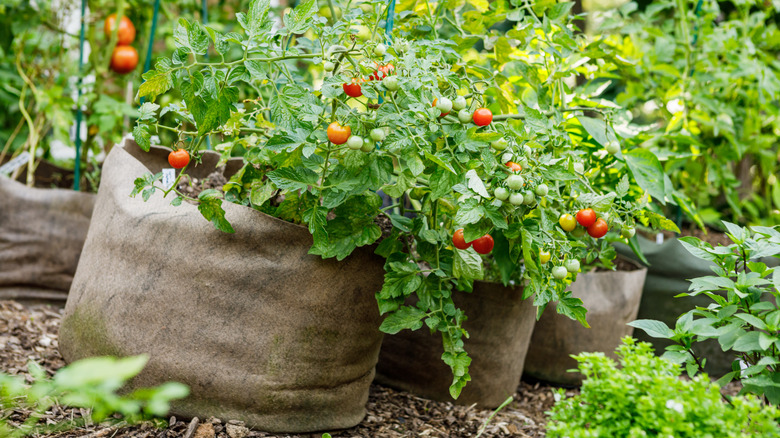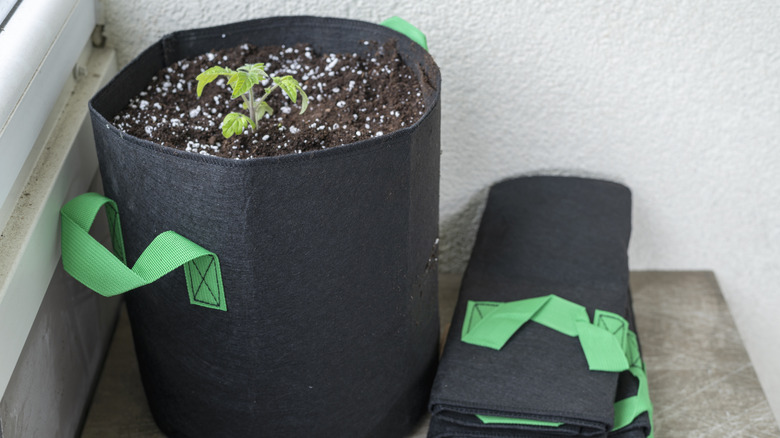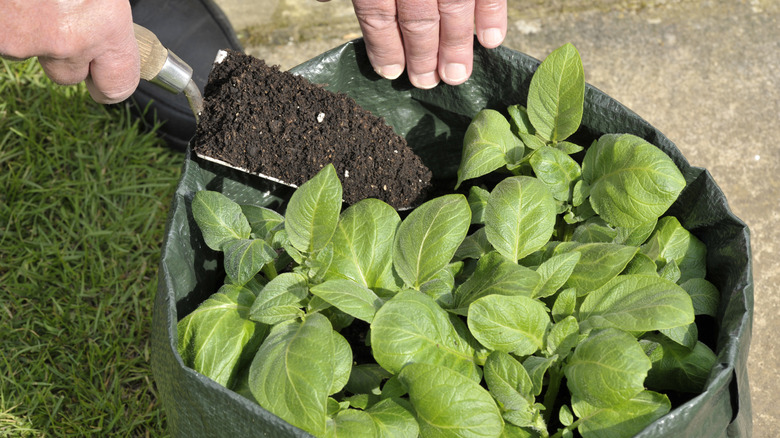The Hidden Downsides Of Fabric Grow Bags You Should Know About
Finding the right planters for your garden can be a recipe for decision fatigue. Every type of planter has both pros and cons, and it's important to consider all sides to make an informed decision. With grow bags, the main downside is that they're usually made of plastic, which leads to microplastic pollution.
Grow bags are often divided into two categories: plastic and fabric. Plastic grow bags are made of a flexible but solid material, similar to a heavy-duty trash bag or reusable shopping bag. By contrast, fabric grow bags are porous and feel similar to felt. However, this terminology can be misleading, because fabric grow bags are typically made of plastic too — just a different kind. Indeed, the majority of modern fabrics incorporate plastic of some kind, such as polyester and nylon.
Fabric grow bags commonly consist of a landscape-fabric-like material made of polyethylene or polypropylene. You may also see the words "geo-fabric" or "geotextile" used for this material. It's popular for a reason: it's durable, sturdy, and breathable. Grow bags also have other perks, like being lightweight and easy to move around. But as with any plastic product, they're not the most environmentally friendly, with the two biggest concerns being their lack of biodegradability and their tendency to release microplastics into the environment.
Why microplastics are a problem
Fabric isn't what we typically associate with plastic pollution. But like any other form of plastic, synthetic fabrics like the ones used for grow bags aren't biodegradable; the material just keeps breaking down into smaller and smaller pieces. Synthetic fabrics are so common that they now account for 35% of ocean microplastic pollution, in addition to releasing microplastics into the air from daily wear and tear. With clothing, many microplastics are shed in the laundry; with grow bags, it's possible that microplastics are shed with each watering session, but there's no research to confirm this.
Microplastics are such a widespread problem that it's likely impossible to avoid them completely — they're in rainwater, food, and throughout the human body. That's worrisome because they've been linked to a range of health problems, from respiratory disorders to inflammatory bowel disease, and scientists are still working to understand the connection. Microplastics can also build up in soil and have been found to negatively affect plant development.
Some popular grow bag brands, like the Root Pouch, are made with recycled water bottles, which in turn are made of polyethylene terephthalate (PET), the most commonly recycled plastic in the US. You might assume that recycled plastic is more environmentally friendly, but some studies have found that it releases even more microplastics than virgin plastic, while other studies have found no difference. If you're looking to ditch the plastic altogether, you can look for grow bags made with natural fabrics such as hemp or jute, though they take a bit more digging to find. Alternatively, go with some terracotta planters instead of a grow bag.
Other downsides of fabric grow bags
Aside from the plastic issue, fabric grow bags may not be the best choice for every garden. Being so lightweight, they are not the sturdiest, so you will likely need to add some support for taller plants when using a fabric grow bag. Additionally, the fabric doesn't provide much insulation, allowing the soil inside to quickly dissipate heat. That's helpful in hot weather, but a downside in cold weather. If you're building a long-term container garden where the plants will stay in one spot year-round, it's worth considering a different kind of planter, like stone or metal.
Fabric grow bags also provide very quick drainage compared to other planters made with thicker, less porous material. It can be difficult to keep up with watering grow bags by hand. Expect to water more frequently — up to daily in hot weather. It may help to use moisture-retaining soil and add mulch on top, or opt for an automatic irrigation system. All that watering will flush nutrients out of the soil more quickly as well, requiring more frequent fertilization.
Lastly, fabric grow bags aren't the most durable type of planter out there. You can clean and reuse grow bags, and those made with high-quality landscape fabric will last a bit longer, but don't expect more than a few years out of each grow bag before it's time to replace it. In contrast, clay pots can last for decades, as can stoneware or metal planters.


